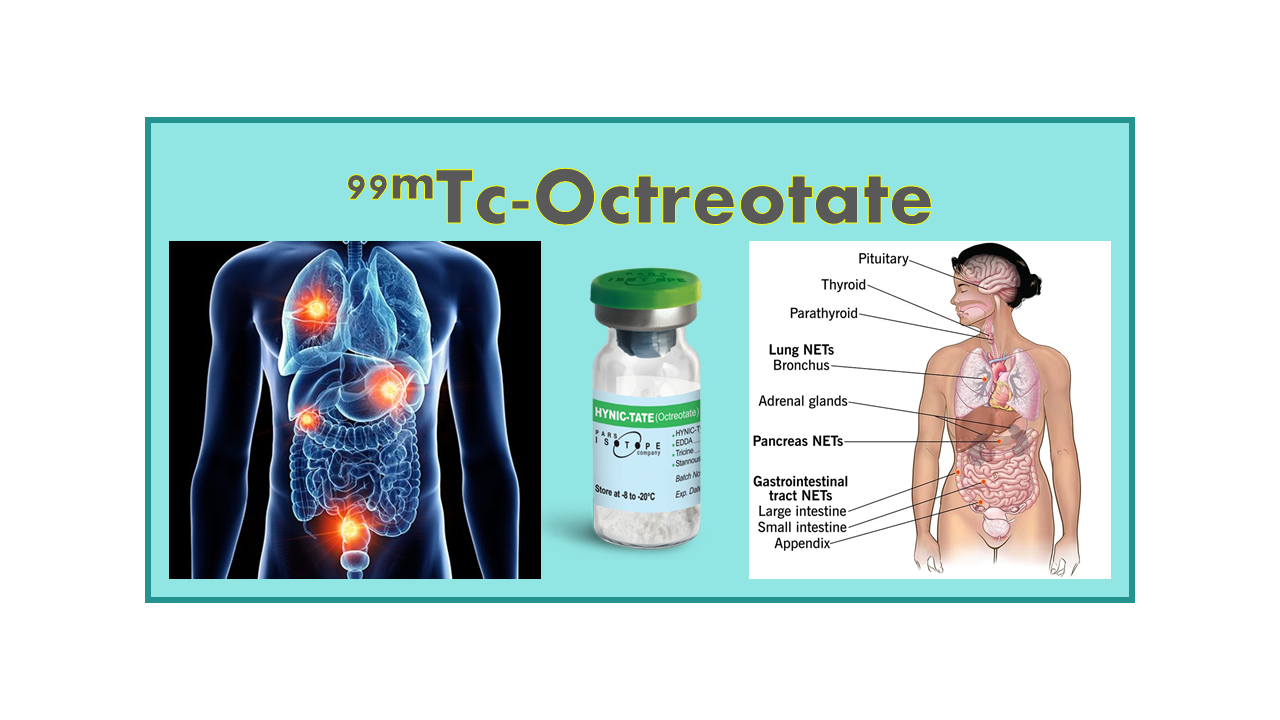
99mTc-Octreotate (EDDA/HYNIC-TATE)
April 12, 2024
99mTc-Octreotate is a crucial radiopharmaceutical agent utilized in nuclear medicine imaging to aid in the localization, staging, and monitoring of therapy for Neuroendocrine Tumors. This specific agent has shown promising results in providing detailed images of neuroendocrine tumors, allowing for accurate diagnosis and treatment planning. Its use in nuclear medicine has significantly improved the ability to detect and monitor these tumors, ultimately leading to better patient outcomes. The continued research and development of 99mTc-Octreotate highlight its importance in the field of oncology and its potential to further enhance the management of Neuroendocrine Tumors.
Neuroendocrine Tumors (NET) are a rare type of cancer that originate in neuroendocrine cells, which are found throughout the body and are responsible for producing hormones. These tumors can develop in various organs, including the pancreas, gastrointestinal tract, lungs, and other parts of the body. NETs are characterized by their ability to secrete hormones, which can lead to a wide range of symptoms depending on the type and location of the tumor.
NETs are classified based on their site of origin, histological features, and hormone secretion. They can be functioning, meaning they produce hormones that cause specific symptoms, or non-functioning, which do not produce hormones and may go undetected until they grow large enough to cause symptoms due to mass effect.
Diagnosis of NETs can be challenging due to their diverse clinical presentations and the need for specialized imaging techniques to localize and characterize the tumors. Imaging modalities such as computed tomography (CT), magnetic resonance imaging (MRI), and nuclear medicine scans using radiopharmaceuticals like 99mTc-Octreotate are commonly used for the diagnosis, staging, and monitoring of NETs.
Treatment of NETs typically involves a multidisciplinary approach, including surgery, targeted therapy, chemotherapy, and somatostatin analogs. The choice of treatment depends on factors such as tumor grade, stage, location, and the presence of hormone secretion.
Overall, NETs are a complex group of tumors that require specialized care and management. The use of advanced imaging techniques, such as 99mTc-Octreotate scans targeting SSTR2-positive tumors, plays a crucial role in the accurate diagnosis and treatment of NETs, especially in the abdomen where these tumors commonly occur.
Description
99mTc-EDDA/HYNIC-[Phe1-Tyr3-Octreotate] (99mTc-Octreotate) sold under the name of 99mTc-Octreotate (Tck-pars-2400) by Pars Isotope is the complement of 99mTc-Octreotide.
Clinical applications
99mTc-Octreotate is recommended for localization, staging, and therapy follow up of NET especially for somatostatin receptor 2 (sstr2) positive tumors in abdomen due to low background activity and rapid clearance in comparison with Octreotide.
Availability
99mTc-Octreotate has been developed and sold by Pars Isotope (99mTc-Octreotate). It was for a long time only available in Iran and provided to other countries only as research tool. More recently (2019), BRIT did bring the kit for this tracer also on the Indian market (TCK-58).
Competition
This tracer is mainly intended for the diagnosis of patients with NET. It is closely related to the use of the therapeutic equivalents such as 90Y- or 177Lu-Octreotide or Octreotate. These therapeutic agents have been used over the past 20 years in the frame of clinical trials or compassionate use and thousands of patients have been treated. As these radiotherapeutic molecules were produced on site at a local radiopharmacy, the same radiochemists were also able to prepare associated imaging agents. Labeling any somatostatin analogue with 99mTc is an option, but playing with a 68Ga analogue has more potential, while the 177Lu-analogues could be used directly as tracers at lower doses. In the meantime, 177Lu-DOTATATE (Lutathera) came on the market while 177Lu-DOTATOC is completing Phase III trial. Both drugs are associated with their 68Ga-labeled analogues which also obtained MA. 99mTc-Octreotate is still of interest in countries in which Lutathera did not obtained a MA and which have limited access to PET for imaging.
In 2013, it was shown that 18F-FDOPA could play an important role in the diagnosis of NET patients.
Comments
Treatment of NET patients with radiolabeled somatostatin analogues has been under development for a long time without real financial support from industry for several years. Only recently one company (AAA), immediately followed by two others (ITM and OctreoPharm) decided to invest more heavily in these products. Since end of 2017 68Ga- DOTATATE and 68Ga-DOTATOC and the therapeutic analogue 177Lu-DOTATATE (Lutathera) became available on the market. The introduction of this drug will definitely make 99mTc-Octreotate of much lower interest, except in countries with no access to the drug with MA. In fact, SPECT imaging agents are not useful for quantification and 99mTc-Tektrotyd, like 111In-Octreoscan will allow diagnosing patients, but are not really useful in adapting the therapeutic dose with the radiolabeled therapeutic analogue. 99mTc- Octreotate may still have some opportunities to play an interesting role in NET diagnostic and therapy.